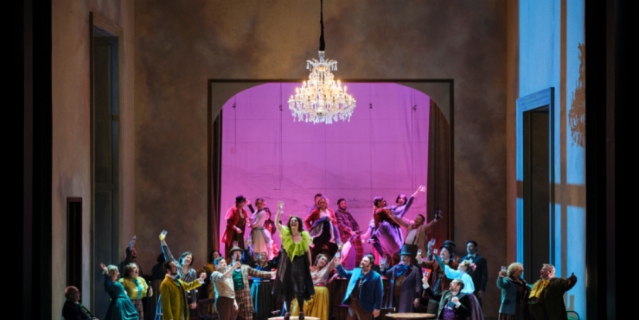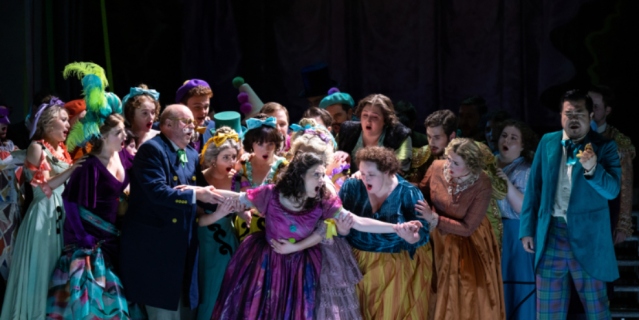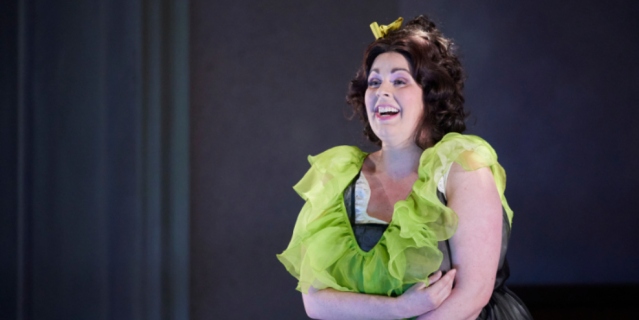 La Traviata – Gaiety Theatre – Review
La Traviata – Gaiety Theatre – Review
by G O’Byrne
Produced by Irish National Opera
La Traviata – Gaiety Theatre Dublin 21st May – 25th May 2024
La Traviata tells the tragic story of the beautiful courtesan Violetta (the fallen woman of the opera’s title) who abandons her glamourous life for true love with her devoted Alfredo. They escape to a rural idyll but Alfredo’s father persuades Violetta to end the affair with Alfredo to avoid disgrace and allow Alfredo’s sister to marry free of family scandal. After much drama, the lovers finally find their way back to each other, but the stress of it all has exacerbated poor Violetta’s consumption. It is a drama of the public and the private, with the surface glamour of the girls and their rich lovers contrasting with the heartfelt emotional pain and suffering of the lead characters. As is unfortunately usual in 19th-century operas, the woman comes off worst.
La Traviata (The Fallen Woman) is an opera in three acts by Giuseppe Verdi set to an Italian libretto by Francesco Maria Piave. It is based on a play by Alexandre Dumas junior. The opera was originally titled Violetta, after the main character. It was first performed on 6 March 1853 at Teatro La Fenice in Venice and is, for many people, one of the best-loved 19th-century operas. It was first performed in Ireland at the Theatre Royal, Dublin on the 14th of October 1856. This production by Irish National Opera and directed by Olivia Fuchs will be performed this week in Wexford, Dublin and Cork.
The setting is Paris in the mid-19th century. It reflects the glamour, opulence and intrigue of the lifestyle that surrounded French courtesans as they charmed, enticed and captivated the wealthy men of Paris. The stage had a dance hall theatrical arch in the background for the courtesans and their gentlemen friends to frolic upon during the bawdy hedonistic party scenes. The opera opens with a sleeping Violetta on her iron frame bed and a striking large chandelier lying on the stage beside her. This rose to the heavens for the party scenes. In the second act, Violetta’s iron bed was dramatically floating above the stage on four wires which made one fear for the performers below! The chandelier returned to the stage beside Violetta’s bed once again for the final drama. Costumes were appropriate for the period and reflected the colourful life of the courtesans depicted.
With many well-known arias, the three main leads were certainly put through their paces by the score. On the night this writer saw the performance, the starring role of Violetta was played by American soprano Amanda Woodbury who brought great drama and passion to the role, rising heroically to the vocal challenges of the role, especially memorable in the arias of the first act (Máire Flavin will perform the role on the 22nd and 24th of May). Alfredo was played by Guatamalan tenor Mario Chang in a powerful and emotional performance (Tenor Yongzhao Yu will play the role on the 22nd and 24th of May). The role of Alfredo’s father Giorgio Germont was very ably played on the night by South Korean baritone Leon Kim (replacing Canadian-Italian baritone Brett Polegato who unfortunately had to step out). Irish baritone Brendan Collins brought swagger to the role of Barone Douphol.
The score contains many well-known operatic highlights and the Irish National Opera Orchestra under the capable baton of Killian Farrell provided sparkling musical backdrop for the performers. The Irish National Opera Chorus were in fine voice and appeared to enjoy themselves thoroughly during the party scenes. For opera fans, this production is one to enjoy if at all possible.
Categories: Header, Theatre, Theatre Review



The opera was conducted by Killian Farrell, not Fergus Sheil.
The conductor is actually Killian Farrell, Fergus Sheil will step in on the final performance in Cork.
Thanks, updated!